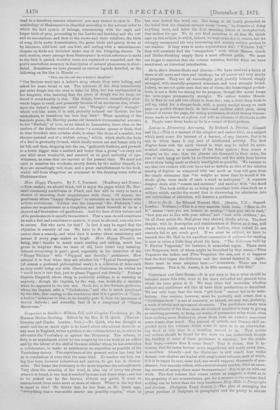CURRENT LITERATURE.
The Ornithology of Shakespeare: Critically Examined Explained, and Illustrated. By James Edmund Harting, F.L.S., F.Z.S. (J. Van Voorst.) —This book will be welcome alike to the ornithologist and to the lover of Shakespeare. Critical without being learned, popularly written and yet not inaccurate, it is a pleasant book to take up in an idle half-hour, and. read in .a desultory manner wherever you may chance to open it. The ornithology of Shakespeare is classified according to the natural order to which the bird spoken of belongs, commencing with the eagle and larger birds of prey, proceeding to the hawks and hawking and the owl and its associations, and then to the crows awl their relations, the birds of song, birds under domestication, the game birds and quarry flown at by faloonere, wild fowl and sea fowl, and ending with a miscellaneous chapter on birds not included under any of the foregoing classes. In each section, every passage from Shakespeare in which reference is made to the bird is quoted, doubtful texts are explained or emended, and the poet's marvellous accuracy in description of natural phenomena is eluci- dated. Sometimes we have pleasant or curious legends detailed, as the following on the lino in Hamlet :— " They soy the owl was a baker's daughter." •
"Our Saviour went into a baker's shop where they were baking, and asked for some broad to eat. The mistress of the shop immediately put some dough into the oven to bake for Him, but was reprimanded by her daughter, who, insisting that the piece of dough was too large, re- duced it considerably in size. The dough, however, immediately after- wards began to swell, and presently became of an enormous size, where- upon the baker's daughter cried out, Wheugh ! whough I wheugh! which owl-like noise, it is said, probably induced our Saviour, for hor wickedness, to transform her into that bird." When speaking of the barnacle goose, Mr. Harting quotes old Gerardo's circumstantial account, in his "'Torben,' of how, on an island in Lancashire, there rises on the surface of the timber washed on shore "a certaine spume or froth, that in time breedeth unto cortaine allele, in shape like those of a musklo, but sharper-pointed and of a whitish colour," within which shells the body of a bird is gradually formed, which finally comes out and hangs only by its bill, and then, dropping into the sea, "gatheroth feathers, and groweth to a fowle bigger than a mallard and lesser than a goose,"—a story not one whit more wonderful, and attested on as good authority of eye- witnesses, as some that are current at the present time. We must not omit to mention the woodcuts, mostly drawn by the author himself, for they are exceedingly well done, and a great embellishment to the book, which will form altogether an ornament to the drawing-room table at Christmas-time.



































 Previous page
Previous page